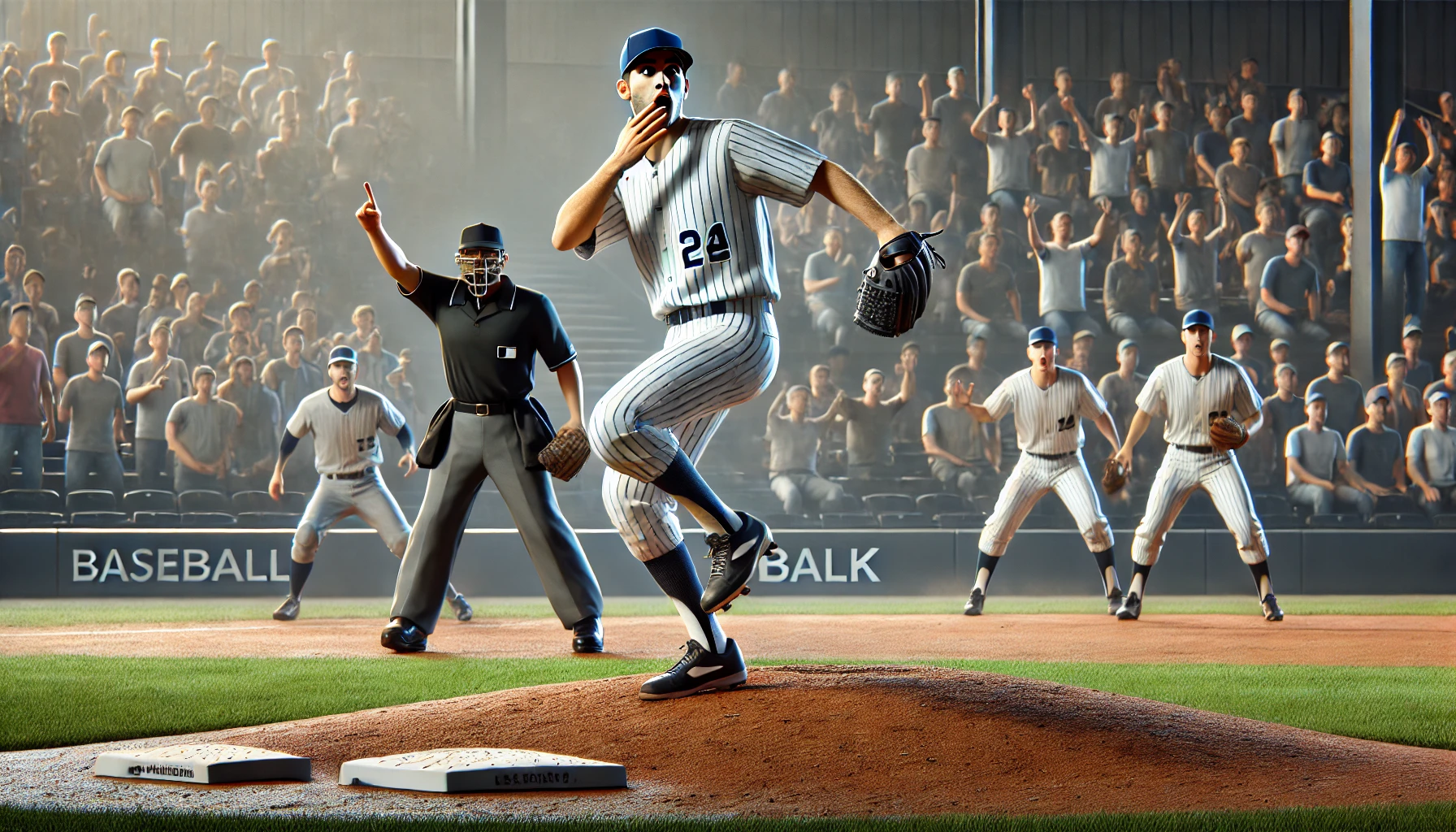Have you ever watched a baseball game and heard the umpire call a balk, but weren’t sure what it meant? Understanding what is balk in baseball can change the way you see the game. A balk can instantly shift momentum, advancing runners and creating scoring opportunities—without a single swing! Whether you’re a fan, player, or coach, knowing the balk rule gives you an edge in understanding the game and avoiding costly mistakes. Ready to dive into this essential rule and improve your baseball knowledge? Let’s explore everything you need to know about balks and how they can impact the game!
What is a Balk in baseball?
A balk in baseball is an illegal move made by the pitcher, and it can have a big impact on the game. In simple terms, a balk happens when the pitcher breaks the rules while trying to pitch or handle runners on base. When the umpire calls a balk, any runners on base get to move to the next base without the need for a hit or any other play.
The main reason for the balk rule is to stop pitchers from tricking or deceiving the batter or the runners. Baseball is built on fairness, and the balk rule ensures that pitchers can’t take unfair advantage by pretending to pitch or doing something that confuses the other team.
How Does a Balk Affect the Game?
When a balk is called, it can change the momentum of the game. If there are runners on base, they automatically advance to the next base, which can put them in a better position to score. For example, if a runner is on third base, a balk could bring them home, giving the offensive team a run without the need for a hit or a play. For pitchers, committing a balk can be stressful and may cause them to lose focus, which could lead to more mistakes.
Understanding what a balk is and how it works can help both players and fans better enjoy and appreciate the game. Balks may not happen often, but when they do, they can have a major impact. That’s why it’s important to know the rules and be aware of how a balk can influence the game!
Common Types of Balks in baseball

A balk can happen in several different ways, and knowing the common types of balks can help both players and fans recognize when one occurs. Each type of balk involves the pitcher making an illegal move that breaks the rules of the game. Below, we’ll break down two of the most common types of balks that happen in baseball.
3.1. Illegal Pitching Movements
One of the most common ways a pitcher can commit a balk is by making an illegal movement while preparing to pitch. Baseball rules require pitchers to follow specific steps when delivering the ball to the batter. If the pitcher starts to throw but suddenly stops, or if they make a motion that looks like a pitch but doesn’t actually throw the ball, the umpire can call a balk. This is because these actions can confuse or trick the batter and runners, giving the pitcher an unfair advantage.
For example, if the pitcher pretends to pitch but doesn’t throw the ball, it may cause a runner to make a move they wouldn’t normally make. This type of deception is why baseball has strict rules to prevent illegal movements on the mound.
3.2. Improper Actions with Runners on Base
Another common type of balk happens when there are runners on base, and the pitcher makes an illegal move to try and stop them from advancing. When a pitcher is set and ready to throw, they must follow certain rules. For instance, if the pitcher lifts their foot off the rubber and makes a quick move to catch a runner off guard, but doesn’t throw the ball, this is a balk. The rules are designed to prevent the pitcher from using unfair tactics to stop the runners.
Other examples include:
- Throwing to a base without stepping directly toward it.
- Dropping the ball while on the mound.
- Making any quick, sudden movements that aren’t part of a normal pitch.
By understanding these common types of balks, players can avoid costly mistakes, and fans can better enjoy the strategy and rules of the game. Knowing the specific movements that lead to a balk can make the game more exciting and engaging!
read: What is OPS in Baseball
Consequences of a Balk in baseball
When a balk is called in baseball, it immediately changes the situation on the field. The main consequence of a balk is that any runners on base get to advance to the next base. This can make a big difference in the game, especially if a runner is close to scoring. Below, we’ll break down the key impacts a balk can have.
- Advancing Runners: If there are runners on base when the umpire calls a balk, each of them automatically moves to the next base. This is a huge advantage for the offensive team because it puts runners in a better position to score without the need for a hit or other action. For example, if a runner is on second base, a balk moves them to third, making it easier for them to score.
- Pitcher Penalties: The pitcher doesn’t just lose control of the game when a balk is called. Committing a balk can shake the pitcher’s confidence and cause them to lose focus. After a balk, the pitcher has to reset and regain control, which can be difficult if they’re already under pressure. This mental impact is one of the most important, but less obvious, consequences of a balk.
- Game Strategy Changes: A balk can change the strategy of both teams. For the defensive team, a balk can ruin a carefully planned play, while for the offensive team, it can create new opportunities to score. Coaches and players must quickly adjust their strategy when a balk occurs to make the most of the new situation.
Understanding the consequences of a balk helps you see how this small rule can have a big impact on the flow of the game. It’s a reminder that every move in baseball counts, and even a simple mistake like a balk can lead to a major shift in momentum.
Recognizing and Avoiding Balks
Recognizing and avoiding balks is crucial for pitchers and coaches to keep control of the game and prevent giving the other team an advantage. By knowing what causes a balk and how to avoid it, pitchers can perform better and avoid costly mistakes. Here are some key tips and strategies to help pitchers avoid balks.
- Stay Focused on Proper Pitching Movements: One of the most effective ways to avoid a balk is to always make clear, legal pitching movements. Pitchers should never stop mid-pitch or make any motions that could confuse the batter or runners. If a pitcher commits to starting a pitch, they must follow through without hesitation. This simple rule helps pitchers avoid the common mistake of stopping or faking a pitch.
- Follow the Rules with Runners on Base: When there are runners on base, pitchers must be extra careful. The most common balks happen when pitchers try to pick off a runner or make quick movements that don’t follow the rules. To avoid this, pitchers need to:
- Always step directly toward the base they are throwing to.
- Avoid sudden, quick movements that aren’t part of their regular pitching motion.
- Make sure they fully understand the rules for pitching with runners on base.
- Practice Pitching with Runners in Mind: Pitchers should practice their techniques in situations where runners are on base. This helps them get used to the pressure of trying to stop runners from stealing bases without committing a balk. The more comfortable a pitcher is in these situations, the less likely they are to make mistakes.
Role of Umpires in Balk Calls
Umpires play an important role in calling balks, and sometimes it can be challenging to catch every minor movement. However, their main job is to ensure that the game stays fair and that pitchers don’t use any illegal moves to trick the runners or batters. While it might feel frustrating when a balk is called, it’s the umpire’s job to uphold the rules and keep the game fair for both teams.
By understanding these key strategies, pitchers can avoid balks and improve their performance. Being aware of the rules and practicing proper movements will help them stay focused and in control during the game.

